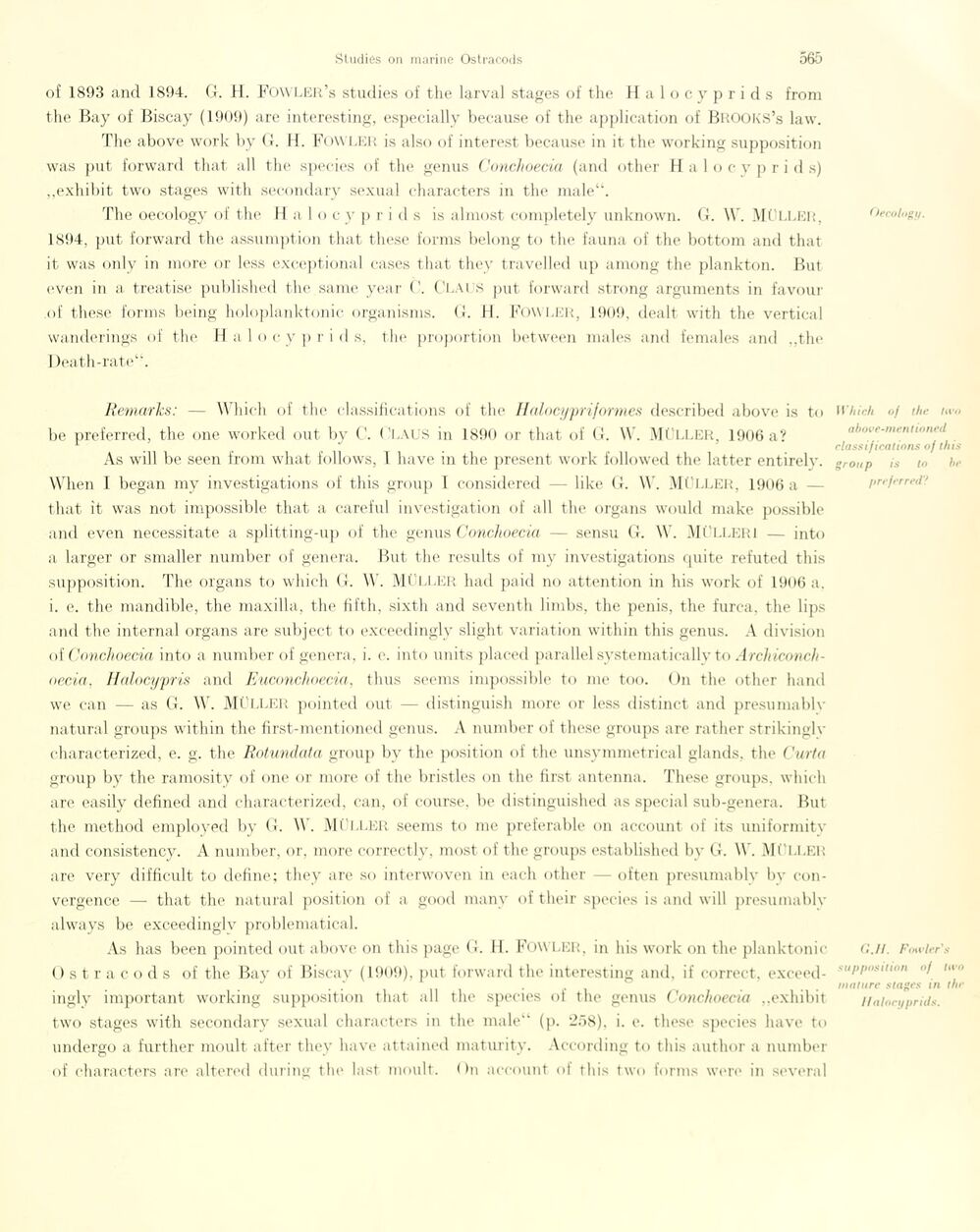
Full resolution (JPEG) - On this page / på denna sida - Sidor ...

<< prev. page << föreg. sida << >> nästa sida >> next page >>
Below is the raw OCR text
from the above scanned image.
Do you see an error? Proofread the page now!
Här nedan syns maskintolkade texten från faksimilbilden ovan.
Ser du något fel? Korrekturläs sidan nu!
This page has never been proofread. / Denna sida har aldrig korrekturlästs.
of 1893 and 1894. G. H. Foyvler’s studies of the larva 1 stages of the Halocyprids from
the Bay of Biscay (1909) are interesting, especially because of the application of BROOKS’s law.
The above work by G. H. Fowler is also of interest because in it the working supposition
was put forward that all the species of the genus Conchoecia (and other H a 1 o c y p r i d s)
„exhibit two stages with secondary sexual characters in the male“.
The oecology of the Halo c y p rids is almost completely unknown. G. \V. MÜLLER,
1894, put forward the assumption that these forms belong to the fauna of the bottom and that
it was only in more or less exceptional cases that they travelled up among the plankton. But
even in a treatise published the same year G. Clals put forward strong arguments in favour
of these forms being holoplanktonie organisms. G. H. FOW LER, 1909, dealt with the vertical
wanderings of the Halocyprids, the proportion between males and females and „the
Death-rate“.
Remarks: — Which of the classifications of the IIalocypriformes described above is to Which o/ the /«•«
be preferred, the one worked out by C. Claus in 1890 or that of G. \V. MULLER, 1906 a?
1 _ classifications of this
As will be seen from what follows, 1 have in the present work followed the latter entirely. group is tn hr
When I began my investigations of this group I considered — like G. \V. MÜLLER, 1906 a —
that it was not impossible that a careful investigation of all the organs would make possible
and even necessitate a splitting-up of the genus Conchoecia — sensu G. W. Müller 1 — into
a larger or smaller number of genera. But the results of my investigations quite refuted this
supposition. The organs to which G. W. MÜLLER had paid no attention in his work of 1906 a.
i. e. the inaudible, the maxilla, the fifth, sixth and seventh limbs, the penis, the furca, the lips
and the internal organs are subject to exceedingly slight variation within this genus. A division
of Conchoecia into a number of genera, i. e. into units placed parallelsystematically to
Archiconch-oecia, Halocypris and Euconchoecia, thus seems impossible to me too. On the other hånd
we can — as G. W. Müller pointed out — distinguish more or less distinct and presumablv
natural groups within the first-mentioned genus. A number of these groups are rather strikinglv
characterized, e. g. the Rotundata group by the position of the unsymmetrical glands, the Curta
group by the ramosity of one or more of the bristles on the first antenna. These groups, which
are easily defined and characterized, can, of course, be distinguished as special sub-genera. But
the method employed by G. \V. MÜLLER seems to me préférable on account of its uniformitv
and consistency. A number, or, more correctly, most of the groups established by G. W. MULLER
are very diffieult to define; they are so interwoven in euch other — often presumablv by
convergence — that the natural position of a good many of their species is and will presumablv
always be exceedingly problematical.
As has been pointed out above on this page G. II. Fowler, in his work on the planktonic G.//. Fowlers
Ostracods of the Bay of Biscay (1909), put forward the interesting and, if correct, exceed- suPPos,l,on "i
J ••ini - . .. mature stages m tin1
ingly important working supposition that all the species ol the genus Conchoecia „exhibit italocypriiis.
two stages with secondary sexual characters in the male“ (p. ‘258). i. e. these species have to
undergo a further moult after they have attained maturity. According to this author a number
of characters are altered during the last moult. On account of this two forms were in several
<< prev. page << föreg. sida << >> nästa sida >> next page >>